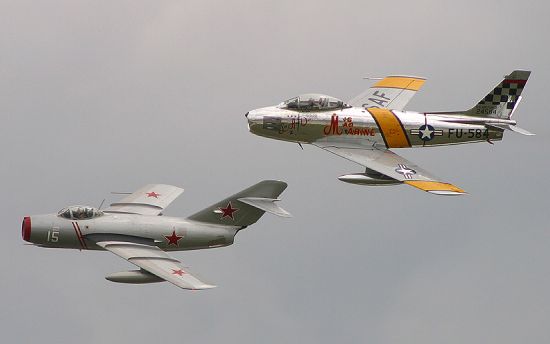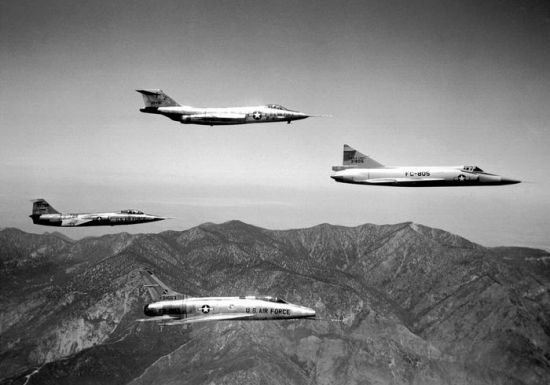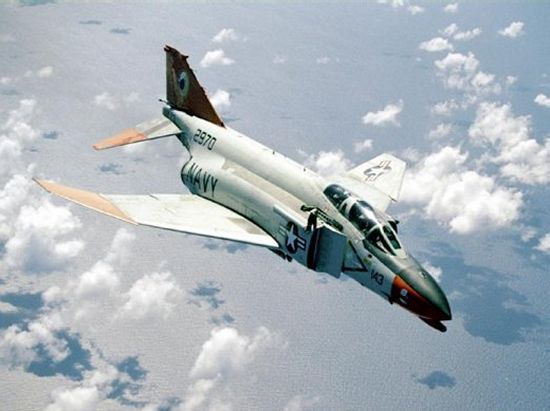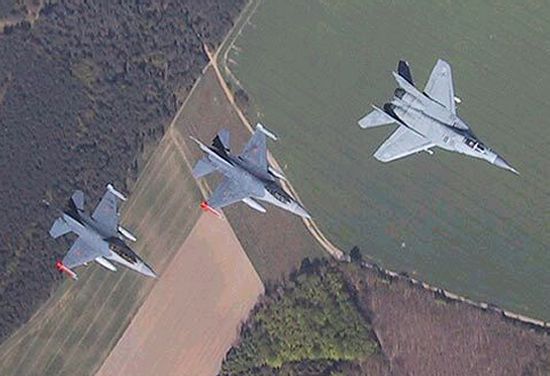|
||||||||||
|
|
||||||||||
|
||||||||||
|
|
||||||||||
That being said, it is still interesting to ponder how the Russians coined that particular phrase in the first place. How is it that they categorized previous fighters into four categories and concluded the next one would be in the fifth generation? Below are described our ideas on what distinguishes one generation from another with examples in each category. While these lists are not intended to be exhaustive or authoritative, they ought to provide a starting point for understanding where the concept of generations comes from.
First Generation Fighters (circa 1945 to 1955)
The first generation of fighters probably consists of those that appeared at the beginning of the Jet Age, starting late in World War II up through the Korean War. These planes were the first to be powered by turbojet engines, but were otherwise largely similar in capability to the older piston-engined fighter they replaced. These early jet engines were limited in thrust such that the fighters could not typically operate above the speed of sound. These first generation fighters were not often equipped with radar. Their armaments also generally consisted of older technologies like conventional guns, dumb bombs, and rockets since guided missiles were still largely experimental.

Perhaps the most representative fighters of that era are the F-86 Sabre and MiG-15, the two planes that fought most fiercely over the skies of Korea. Other fighters in this generation include:
Second Generation Fighters (circa 1955 to 1960)
The factors that most epitomized fighters of the second generation were higher speed, radar, and use of the first guided air-to-air missiles. Many of these aircraft incorporated lessons learned in Korea to improve overall performance and combat effectiveness. These aircraft were the first fighters capable of maintaining supersonic speeds in level flight. Their designs also took advantage of new electronics technologies making radar small enough to be carried aboard. Similarly, advances in guided missile development allowed this new weapon to begin replacing the gun as the primary offensive weapon for the first time in fighter history.

Best representing this class of fighters is the American "Century Series." Other members of the second generation include:
Third Generation Fighters (circa 1960 to 1970)
Many of the fighters of the third generation were those that served in the Vietnam War, particularly in the latter stages of the conflict. Most of these planes were the first to be designed specifically as multi-purpose fighters capable of performing both air defense and ground attack missions.

Perhaps the best representative of this generation of fighters is the F-4 Phantom II, which entered service not only with the US Navy, Marines, and Air Force, but also with a number of foreign militaries. Other examples of third generation fighters include:
Fourth Generation Fighters (circa 1970 to 1990)
The next generation continued the trend towards multi-role fighters equipped with increasingly sophisticated avionics and weapon systems. These fighters also began emphasizing maneuverability rather than speed to succeed in air-to-air combat.

Good representatives of this class of fighter include the American F-16 and Soviet MiG-29. Other members of the fourth generation include:
4.5 Generation Fighters (circa 1990 to 2000)
The term "4.5 generation" is also sometimes seen refering to more recent fourth generation fighters. These aircraft are generally seen as retaining the same basic characteristics of fourth generation planes but with enhanced capabilities provided by more advanced technologies that might be seen in fifth generation fighters. Good examples are the F-18 Super Hornet, Eurofighter Typhoon, and Dassault Rafale. All three make use of advanced avionics to improve mission capability and limited stealth characteristics to reduce visibility when compared to older fourth generation aircraft. However, none is considered advanced enough to be classified as a fifth generation fighter (though arguments can be made for the Typhoon and perhaps the Rafale).

Other members of this generation include:
Fifth Generation Fighters (circa 2000 to ?)
The technologies that best epitomize fifth generation fighters are advanced integrated avionics systems that provide the pilot with a complete picture of the battlespace and the use of low observable "stealth" techniques. The F-22 and F-35 are the only fifth generation fighters developed to date, but Russia hopes that technologies being created by the Mikoyan Gurevich MFI and Sukhoi Su-47 may make them competitors in that market.

It only seems logical to name the F-35 as the ultimate example of this generation since the Joint Strike Fighter was the original inspiration for this entire subject. Other examples include:
Related Topics:
Can you explain the codename system used for Soviet planes during the Cold War?
Read More Articles:


|
Aircraft | Design | Ask Us | Shop | Search |

|
|
| About Us | Contact Us | Copyright © 1997-2023 | |||
|
|
|||